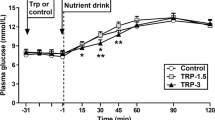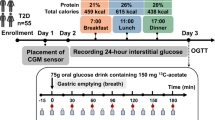Abstract
Background/Aim:
Liraglutide, a glucagon-like peptide-1 analog, induces weight loss. We investigated whether liraglutide affects gastric accommodation and satiation by measuring the intragastric pressure (IGP) during nutrient-drink consumption and using the barostat technique.
Methods:
Ten healthy volunteers (HVs) were tested after placebo, 0.3, 0.6 or 1.2 mg liraglutide administration. IGP was studied during intragastric nutrient-drink (1.5 kcal ml−1) infusion (60 ml min−1), while the HVs scored their satiation on a graded scale until maximal satiation. In a separate session, isobaric distentions were performed using the barostat with stepwise increments of 2 mm Hg starting from minimal distending pressure, although HVs scored their perception; gastric volume was monitored 30 min before and until 60 min after ingestion of 200 ml of nutrient drink. Data are presented as mean±s.e.m. comparisons were performed with ANOVA (P<0.05 was significant).
Results:
During nutrient-drink infusion, IGP decreased with 4.1±0.7, 3.0±0.4, 2.1±0.3 and 2.6±0.4 mm Hg (placebo, 0.3, 0.6 and 1.2 mg liraglutide, respectively; P<0.05). The maximum-tolerated volume was not different, except after treatment with 1.2 mg liraglutide (695±135 ml) compared with placebo (1008±197 ml; P<0.05); however, 1.2 mg liraglutide induced nausea in all volunteers. In the barostat study, liraglutide did not affect the perception or compliance, but significantly decreased gastric accommodation to the meal (168±27 vs 78.8±36.4 ml after treatment with placebo and 0.6 mg liraglutide, respectively; P<0.05).
Conclusion:
Although no effect on perception, compliance or satiation was observed, liraglutide inhibited gastric accommodation. Whether this effect is involved in the anorectic effect of liraglutide remains to be determined.
This is a preview of subscription content, access via your institution
Access options
Subscribe to this journal
Receive 12 print issues and online access
$259.00 per year
only $21.58 per issue
Buy this article
- Purchase on Springer Link
- Instant access to full article PDF
Prices may be subject to local taxes which are calculated during checkout




Similar content being viewed by others
Abbreviations
- IGP:
-
intragastric pressure
- GLP-1:
-
glucagon-like peptide-1
- DPP-IV:
-
dipeptidyl peptidase-IV
- HRM:
-
high-resolution manometry
- HVs:
-
healthy volunteers
- SC:
-
subcutaneous
- LES:
-
lower esophageal sphincter
- MDP:
-
minimal distending pressure
References
Schwartz GJ . Integrative capacity of caudal brainstem in the control of food intake. Philos Trans R Soc Lond B Biol Sci Ser B 2006; 361: 1275–1280.
Janssen P, Vanden Berghe P, Verschueren S, Lehmann A, Depoortere I, Tack J . Review Article: the role of gastric motility in the control of food intake. Aliment Pharmacol Ther 2011; 33: 880–894.
Tack J, Caenepeel P, Piessevaux H, Cuomo R, Janssens J . Assessment of meal induced gastric accomodation by a satiety drinking test in health and in severe functional dyspepsia. Gut 2003; 52: 1271–1277.
Schirra J, Katschinski M, Weidmann C, Schafer T, Wank U, Arnold R et al. Gastric emptying and release of incretin hormones after glucose ingestion in humans. J Clin Invest 1996; 97: 92–103.
Gutzwiller JP, Göke B, Drewe J, Hildebrand P, Ketterer S, Handschin D et al. Glucagon-like peptide-1: a potent regulator of food intake in humans. Gut 1999; 44: 81–86.
Van Dijk G, Thiele TE . Glucagon-like peptide-1 (7-36) amide: a central regulator of satiety and interoceptive stress. Neuropeptides 1999; 33: 406–414.
Giralt M, Vergara P . Glucagonlike peptide-1 (GLP-1) participation in ileal brake induced by intraluminal peptones in rat. Dig Dis Sci 1999; 44: 322–329.
Schirra J, Houck P, Wank U, Arnold R, Goke B, Katschinski M . Effects of glucagon-like peptide-1 (7-36) amide on antro-pyloro-duodenal motility in the interdigestive state and with duodenal lipid perfusion in humans. Gut 2000; 46: 622–631.
Anvari M, Paterson CA, Daniel EE, McDonald TJ . Effects of GLP-1 on gastric emptying, antropyloric motility, and transpyloric flow in response to a nonnutrient liquid. Dig Des Sci 1998; 43: 1133–1140.
Tolessa T, Gutniak M, Holst JJ, Efendic S, Hellstrom PM . Glucagon-like peptide-1 retards gastric emptying and small bowel transit in the rat: effect mediated through central or enteric nervous mechanisms. Dig Dis Sci 1998; 43: 2284–2290.
Delgado-Aros S, Kim DY, Burton DD, Thomforde GM, Stephens D, Brinkmann BH et al. Effect of GLP-1 on gastric volume, emptying, maximum volume ingested, and postprandial symptoms in humans. Am J Physiol Gastrointest Liver Physiol 2002; 282: G424–G431.
Andrews CN, Bharucha AE, Camilleri M, Low PA, Seide BM, Burton DD et al. Effects of glucagons-like peptide-1 and sympathetic stimulation on gastric accommodation in humans. Neurogastroenterol Motil 2007; 19: 716–723.
Andrews CN, Bharucha AE, Camilleri M, Low PA, Seide B, Burton D et al. Nitrergic contribution to gastric relaxation induced by glucagons-like peptide-1 (GLP-1) in healthy adults. Am J Physiol Gastrointest Liver Physiol 2007; 292: G1359–1365.
Amato A, Cinci L, Rotondo A, Serio R, Faussone-Pellegrini MS, Vannucchi MG et al. Pheriperal motor action of glucagon like peptide-1 through enteric neuronal receptors. Neurogastroenterol Motil 2010; 22: 664–672.
Rotondo A, Amato A, Lentini L, Baldassano S, Mulè F . Glucagon-like peptide-1 relaxes gastric antrum through nitric oxide in mice. Peptides 2011; 32: 60–64.
Drucker DJ, Nauck MA . The incretin system: glucagon-like peptide-1 receptor agonists and dipeptidyl peptidase-4 inhibitors in type 2 diabetes. Lancet 2006; 368: 1696–1705.
Knudsen LB, Nielsen PF, Huusfeldt PO, Johansen NL, Madsen K, Pedersen FZ et al. Potent derivatives of glucagon-like peptide-1 with pharmacokinetic properties suitable for once daily administration. J Med Chem 2000; 43: 1664–1669.
Mikhail NE . Is liraglutide a useful addition to diabetes therapy? Endocr Pract 2010; 16: 1028–1037.
Astrup A, Rossner S, Van Gaal L, Rissanen A, Niskanen L, Al Hakim M et al. Lean ME NN8022-1807 Study Group. Effects of liraglutide in the treatment of obesity: a randomized, double-blind, placebo controlled study. Lancet 2009; 374: 1606–1616.
Garber A, Henry R, Ratner R, Garcia-Hernandez PA, Rodriguez-Pattzi H, Olvera-Alvarez I et al. LEAD-3 (Mono) Study group. Liraglutide versus glimepiride monotherapy for the type 2 diabetes (LEAD-3 Mono): a randomized; 52-week, phase III, double blind, parallel-treatment trial. Lancet 2009; 374: 473–481.
Nauck M, Frid A, Hermansen K, Shah NS, Tankova T, Mitha IH et al. LEAD-2 Study Group. Efficacy and safety comparison of liraglutide, glimiperide and placebo, all in combination with metformin, in type 2 diabetes. The LEAD (liraglutide effect and action in diabetes)-2 study. Diabetes Care 2009; 32: 84–90.
Zinman B, Gerich J, Buse JB, Lewin A, Schwartz S, Raskin P et al. LEAD-4 Study Investigators. Efficacy and safety of the human glucagon-like peptide-1 analog liraglutide in combination with metformin and thiazolidinedione in patients with type 2 diabetes (LEAD-4 Met+ TZD). Diabetes Care 2009; 32: 1224–1230.
Kapitza C, Zdravkotic M, Zijlstra E, Segel S, Heise T, Flint A . Effect of three different injection sites on the pharmacokinetics of the once-daily human GLP-1 analogue liraglutide. J Clin Pharmacol 2011; 51: 951–955.
Janssen P, Verschueren S, Ly GH, Vos R, Van Oudenhove L, Tack J . Intragastric pressure during food intake: a physiological and minimally invasive method to assess gastric accommodation. Neurogastroenterol Mot 2011; 23: 316–322.
Tack J, Caenepeel P, Fischler B, Piessevaux H, Janssens J . Symptoms associated with hypersensitivity to gastric distention in functional dyspepsia. Gastroenterology 2001; 121: 526–535.
Notivol R, Coffin B, Azpiroz F, Mearin F, Serra J, Malagelada JR . Gastric tone determines the sensitivity of the stomach to distention. Gastroenterology 1995; 108: 330–6.
Kindt S, Tack J . Impaired gastric accommodation and its role in dyspepsia. Gut 2006; 55: 1685–1691.
Azpiroz F, Malagelada JR . Perception and reflex relaxation of the stomach in response to gut distention. Gastroenterology 1990; 98: 1193–1198.
Mundt MW, Hausken T, Samsom M . Effect of intragastric barostat bag on proximal and distal gastric accommodation in response to liquid meal. Am J Physiol Gastrointest Liver Physiol 2002; 283: G681–G686.
Van den Elzen BD, Bennink RJ, Wieringa RE, Tytgat GN, Boeckxstaens GE . Fundic accommodation assessed by SPECT scanning: comparison with the gastric barostat. Gut 2003; 52: 1548–1554.
Wettergren A, Maina P, Boesby S, Holst JJ . Glucagon-like peptide-1 7-36 amide and peptide YY have additive effect on gastric acid secretion in man. Scand J Gastroenterol 1997; 32: 552–555.
Lee KJ, Kindt S, Tack J . Pathophysiology if functional dyspepsia. Best Pract Res Clin Gastroenterol 2004; 18: 707–716.
Marre M, Shaw J, Brändle M, Bebakar WM, Kamaruddin NA, Strand J et al. LEAD-1 SU study group. Liraglutide, a once-daily human GLP-1 analogue, added to a sulphonylurea over 26 weeks produces greater improvements in glycaemic and weight control compared with adding rosiglitazone or placebo in subjects with Type 2 diabetes (LEAD-1 SU). Diabet Med 2009; 26: 268–278.
Harder H, Nielsen L, Tu DT, Astrup A . The effect of liraglutide, a long-acting glucagon-like peptide 1 derivative, on glycemic control, body composition, and 24-h energy expenditure in patients with type 2 diabetes. Diabetes Care 2004; 27: 1915–1921.
Degn KB, Juhl CB, Sturis J, Jakobsen G, Brock B, Chandramouli V et al. One week′s treatment with the long-acting glucagon-like peptide 1 derivative liraglutide (NN2211) markedly improves 24-h glycemia and alpha- and beta-cell function and reduces endogenous glucose release in patients with type 2 diabetes. Diabetes 2004; 53: 1187–1194.
Juhl CB, Hollingdal M, Sturis J, Jakobsen G, Agersø H, Veldhuis J et al. Bedtime administration of NN2211, a long-acting GLP-1 derivative, substantially reduces fasting and postprandial glycemia in type 2 diabetes. Diabetes 2002; 51: 424–429.
Author information
Authors and Affiliations
Corresponding author
Rights and permissions
About this article
Cite this article
Rotondo, A., Janssen, P., Mulè, F. et al. Effect of the GLP-1 analog liraglutide on satiation and gastric sensorimotor function during nutrient-drink ingestion. Int J Obes 37, 693–698 (2013). https://doi.org/10.1038/ijo.2012.101
Received:
Revised:
Accepted:
Published:
Issue Date:
DOI: https://doi.org/10.1038/ijo.2012.101
Keywords
This article is cited by
-
GLP-1: benefits beyond pancreas
Journal of Endocrinological Investigation (2014)



